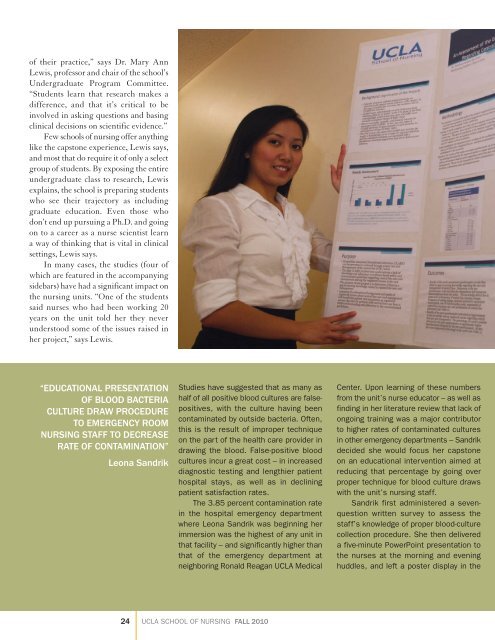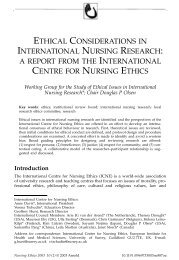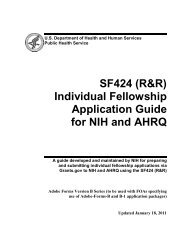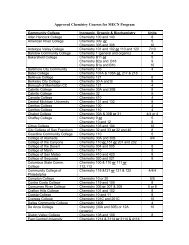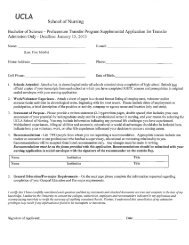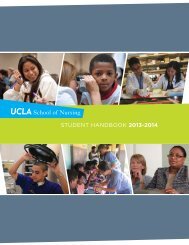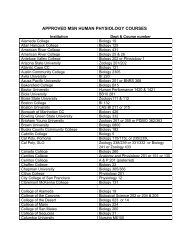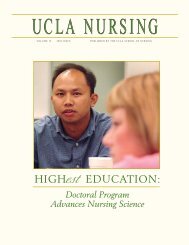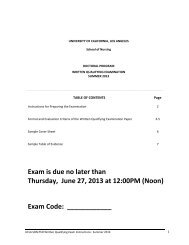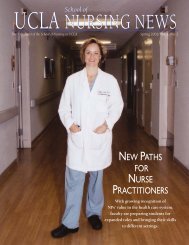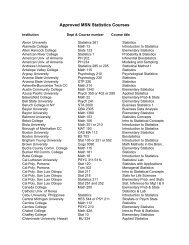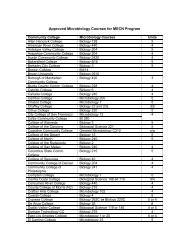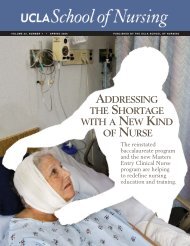proof positive - UCLA School of Nursing
proof positive - UCLA School of Nursing
proof positive - UCLA School of Nursing
You also want an ePaper? Increase the reach of your titles
YUMPU automatically turns print PDFs into web optimized ePapers that Google loves.
<strong>of</strong> their practi ce,” says Dr. Mary Ann<br />
Lewis, pr<strong>of</strong>essor and chair <strong>of</strong> the school’s<br />
Undergraduate Program Committee.<br />
“Students learn that research makes a<br />
difference, and that it’s critical to be<br />
involved in asking questions and basing<br />
clinical decisions on scientific evidence.”<br />
Few schools <strong>of</strong> nursing <strong>of</strong>fer anything<br />
like the capstone experience, Lewis says,<br />
and most that do require it <strong>of</strong> only a select<br />
group <strong>of</strong> students. By exposing the entire<br />
undergraduate class to research, Lewis<br />
explains, the school is preparing students<br />
who see their trajectory as including<br />
graduate education. Even those who<br />
don’t end up pursuing a Ph.D. and going<br />
on to a career as a nurse scientist learn<br />
a way <strong>of</strong> thinking that is vital in clinical<br />
settings, Lewis says.<br />
In many cases, the studies (four <strong>of</strong><br />
which are featured in the accompanying<br />
sidebars) have had a significant impact on<br />
the nursing units. “One <strong>of</strong> the students<br />
said nurses who had been working 20<br />
years on the unit told her they never<br />
understood some <strong>of</strong> the issues raised in<br />
her project,” says Lewis.<br />
“eduCAtionAl presentAtion<br />
<strong>of</strong> Blood BACteriA<br />
Culture drAw proCedure<br />
to emergenCy room<br />
nursing stAff to deCreAse<br />
rAte <strong>of</strong> ContAminAtion”<br />
leona sandrik<br />
Studies have suggested that as many as<br />
half <strong>of</strong> all <strong>positive</strong> blood cultures are false<strong>positive</strong>s,<br />
with the culture having been<br />
contaminated by outside bacteria. Often,<br />
this is the result <strong>of</strong> improper technique<br />
on the part <strong>of</strong> the health care provider in<br />
drawing the blood. False-<strong>positive</strong> blood<br />
cultures incur a great cost – in increased<br />
diagnostic testing and lengthier patient<br />
hospital stays, as well as in declining<br />
patient satisfaction rates.<br />
The 3.85 percent contamination rate<br />
in the hospital emergency department<br />
where Leona Sandrik was beginning her<br />
immersion was the highest <strong>of</strong> any unit in<br />
that facility – and significantly higher than<br />
that <strong>of</strong> the emergency department at<br />
neighboring Ronald Reagan <strong>UCLA</strong> Medical<br />
Center. Upon learning <strong>of</strong> these numbers<br />
from the unit’s nurse educator – as well as<br />
finding in her literature review that lack <strong>of</strong><br />
ongoing training was a major contributor<br />
to higher rates <strong>of</strong> contaminated cultures<br />
in other emergency departments – Sandrik<br />
decided she would focus her capstone<br />
on an educational intervention aimed at<br />
reducing that percentage by going over<br />
proper technique for blood culture draws<br />
with the unit’s nursing staff.<br />
Sandrik first administered a sevenquestion<br />
written survey to assess the<br />
staff’s knowledge <strong>of</strong> proper blood-culture<br />
collection procedure. She then delivered<br />
a five-minute PowerPoint presentation to<br />
the nurses at the morning and evening<br />
huddles, and left a poster display in the<br />
24 <strong>UCLA</strong> SCHOOL OF NURSING fAll 2010


